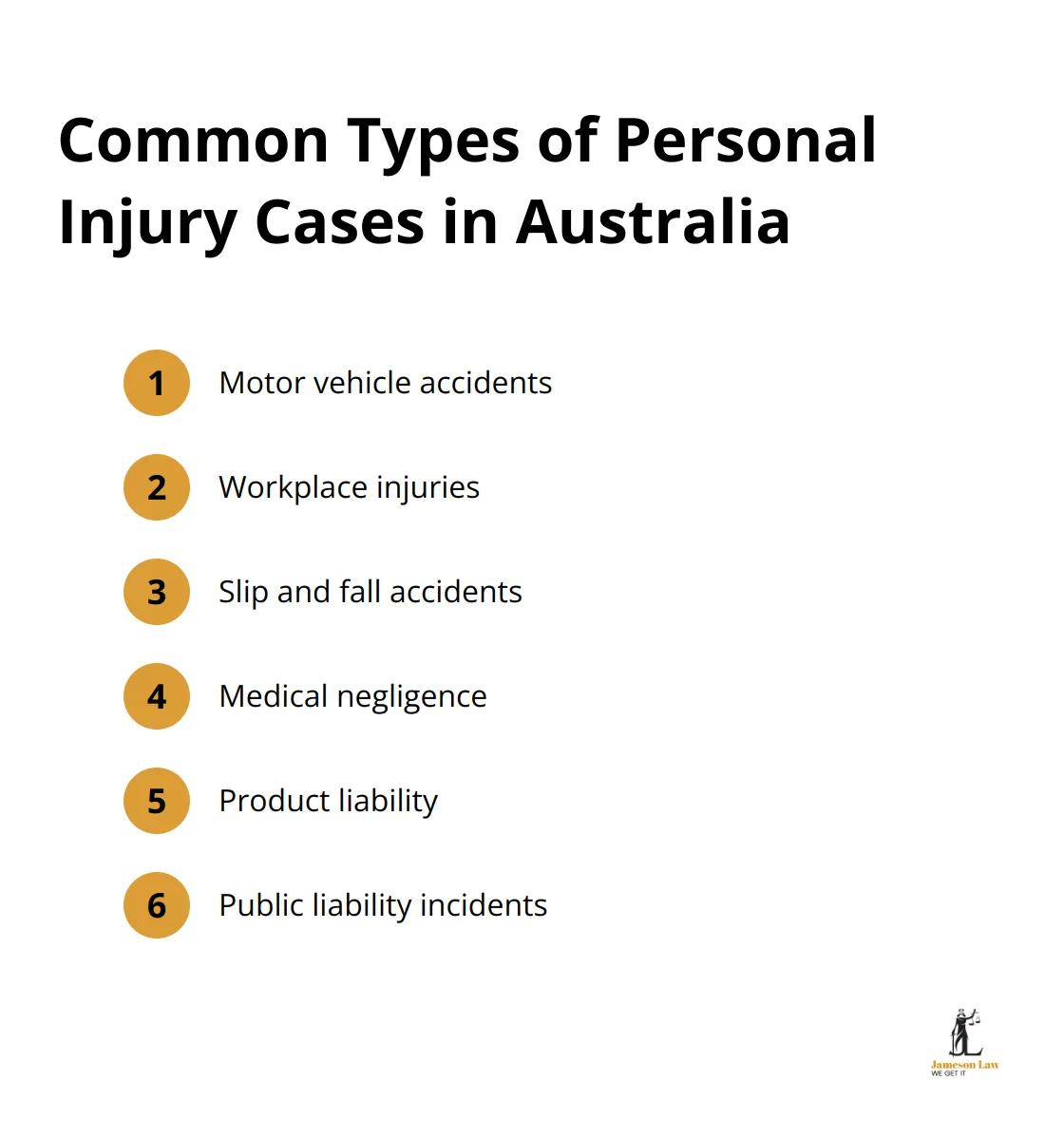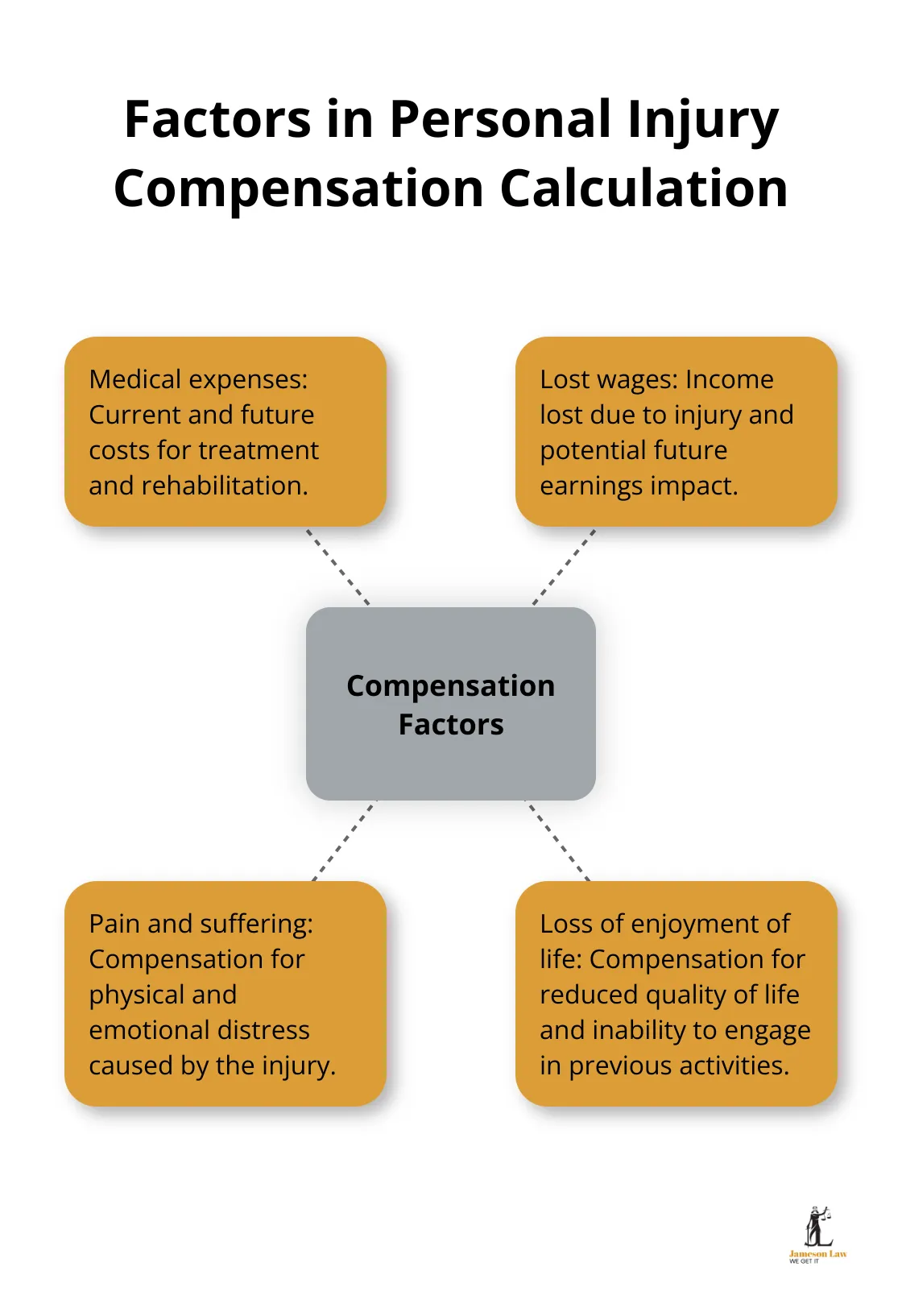Personal injury law is a complex field that protects individuals who have been harmed due to someone else’s negligence or intentional actions. At Jameson Law, we often encounter clients seeking clarity on the personal injury law definition and its implications.
This guide will break down the basics of personal injury law in Australia, covering common case types, the claims process, and key considerations for those affected.
What Is Personal Injury Law?
Definition and Scope
Personal injury law in Australia is a legal framework that allows individuals to seek compensation for injuries caused by another party’s negligence or intentional actions. This area of law aims to protect victims and hold responsible parties accountable for their actions.
Types of Personal Injury Cases
Personal injury law covers a wide range of incidents. In Australia, some of the most common types of personal injury cases include:
- Motor vehicle accidents
- Workplace injuries
- Slip and fall accidents
- Medical negligence
- Product liability
- Public liability incidents
Each of these case types has its own set of legal considerations and potential compensation outcomes.

Key Elements of a Personal Injury Claim
To successfully pursue a personal injury claim in Australia, several key elements must be present:
- Duty of Care: The responsible party must have owed a duty of care to the injured person. For example, drivers owe a duty of care to other road users.
- Breach of Duty: Evidence must show that the responsible party breached their duty of care through negligence or intentional actions.
- Causation: The breach of duty must have directly caused the injury or harm suffered by the victim.
- Damages: The injured person must have suffered actual damages (which can include physical injuries, emotional distress, or financial losses).
Time Limits and Legal Considerations
It’s important to be aware of the time limits for filing a personal injury claim in Australia. These limits, known as statutes of limitations, vary depending on the type of case and the state or territory where the incident occurred. For instance, in most cases, personal injury claims must be brought within 3 years from the time the cause of action arose.
Understanding the complexities of personal injury law and the importance of acting quickly to protect your rights is essential. An experienced legal team can guide you through the legal process, ensuring you meet all neccessary deadlines and requirements for your claim.
The Role of Legal Representation
Navigating the personal injury claims process can be challenging, especially when dealing with insurance companies and complex legal procedures. Legal representation can provide valuable support and expertise throughout your claim. A skilled personal injury lawyer will:
- Assess the merits of your case
- Gather and present evidence effectively
- Negotiate with insurance companies on your behalf
- Represent you in court if neccessary
With the basics of personal injury law covered, let’s explore the common types of personal injury cases in Australia and how they’re handled within the legal system.
Common Personal Injury Cases in Australia
Personal injury cases in Australia encompass a wide range of incidents, each with unique legal considerations. This chapter explores the most frequent types of personal injury claims and their specific characteristics.
Motor Vehicle Accidents
Motor vehicle accidents top the list of personal injury cases in Australia. These accidents often result in severe injuries, including whiplash, spinal cord damage, and traumatic brain injuries.
Determining fault is a key aspect of motor vehicle accident cases. This process involves analysis of police reports, witness statements, and (in some cases) input from accident reconstruction experts. Insurance companies play a significant role, often attempting to minimise payouts. To build a strong case, it’s essential to collect comprehensive evidence, including medical records and expert testimonies.
Workplace Injuries
Workplace injuries form another common category of personal injury cases. Safe Work Australia reported 183 worker fatalities in 2019 due to injuries sustained in the course of a work-related activity.

These injuries range from repetitive strain injuries to more severe incidents like falls from heights or machinery accidents.
Understanding the Workers’ Compensation scheme is vital in workplace injury cases. This no-fault system provides compensation for medical expenses and lost wages. However, in cases of severe negligence, employees might have grounds for additional claims against their employer.
Slip and Fall Accidents
Slip and fall accidents, often categorised under public liability claims, occur frequently in Australia. These can happen in various settings, from supermarkets to public footpaths. The key in these cases is to prove that the property owner or occupier failed to maintain a safe environment.
Evidence such as CCTV footage, photographs of the hazard, and witness statements often determine the success of slip and fall claims. Immediate reporting of the incident and seeking medical attention are important steps, as delays can weaken the claim.
Medical Negligence
Medical negligence cases involve complex legal and medical considerations. These cases require proof that a healthcare provider failed to provide an acceptable standard of care, resulting in harm to the patient. Common examples include surgical errors, misdiagnosis, and medication mistakes.
In Australia, medical negligence claims have a high threshold for proof. Expert medical opinions are usually neccessary to establish that the care provided fell below the accepted standard.
Product Liability
Product liability cases involve injuries caused by defective or unsafe products, ranging from faulty household appliances to dangerous pharmaceuticals. In Australia, the Australian Competition and Consumer Commission (ACCC) plays a key role in product safety regulation.
To succeed in a product liability claim, it’s neccessary to prove that the product was defective and that this defect caused the injury. This often involves expert analysis of the product and its manufacturing process. In some cases, these claims can lead to large-scale recalls and class actions.
Understanding these common types of personal injury cases provides a foundation for navigating the legal landscape. The next chapter will explore the personal injury claims process in Australia, detailing the steps involved from filing a claim to receiving compensation.
Navigating the Personal Injury Claims Process
Initiate Your Claim
The personal injury claims process in Australia starts with notifying the person who caused your injury (the ‘respondent’) of your intention to make a claim. This notification is given in two parts, Part 1 and Part 2. Seeking immediate medical attention is also crucial. This step ensures your health and safety and creates a medical record that serves as vital evidence for your claim.
After medical treatment, report the incident to the relevant authorities. For workplace injuries, inform your employer. For motor vehicle accidents, contact the police. For public liability cases, notify the property owner or manager. This reporting creates an official record of the incident, which is essential for your claim.
Next, consult with a personal injury lawyer. Many law firms offer free initial consultations to assess your case. During this consultation, provide all relevant information and documentation about your injury and the incident.
Meet Critical Deadlines
Time limits for personal injury claims in Australia are strict and vary depending on the type of claim and the state or territory. Generally, you have three years from the date of injury to file a claim, but some cases have shorter timeframes. For example, in New South Wales, you must notify the at-fault party of a motor vehicle accident claim within six months of the incident.
Missing these deadlines can result in your claim being barred, so act promptly.
Gather and Preserve Evidence
Strong evidence forms the foundation of a successful personal injury claim. This includes:
- Medical records and bills
- Photographs of injuries and the accident scene
- Witness statements
- Police reports
- Employment records for lost wage claims
The Australian Lawyers Alliance stresses the importance of preserving evidence, as it can significantly influence the outcome of your claim. Keep a detailed record of how your injury affects your daily life, including pain levels, mobility issues, and emotional impact.
Deal with Insurance Companies
Insurance companies play a significant role in personal injury claims. They often try to minimise payouts, so approach interactions with them cautiously. Avoid giving recorded statements without legal advice, and don’t accept initial settlement offers without understanding the full extent of your injuries and future medical needs.
Calculate Compensation
Compensation in personal injury claims is calculated based on various factors, including:
- Medical expenses (current and future)
- Lost wages and loss of earning capacity
- Pain and suffering
- Loss of enjoyment of life
However, the specific compensation amount varies widely depending on the severity of the injury and the circumstances of the case.

Final Thoughts
Personal injury law in Australia protects individuals who have suffered harm due to someone else’s negligence or intentional actions. The personal injury law definition encompasses a wide range of situations, from motor vehicle accidents to medical negligence, where individuals may seek compensation. The claims process involves critical steps such as initiating the claim, meeting deadlines, and gathering evidence.
Professional legal advice plays a vital role in navigating the complexities of personal injury cases. An experienced lawyer can guide you through the legal system, ensure you meet all deadlines, and help you build a strong case. At Jameson Law, we offer expert legal services across various areas of personal injury law.
Time limits for personal injury claims in Australia are strict and vary depending on the type of claim and jurisdiction. If you believe you have a valid claim, seek legal advice promptly to protect your interests and pursue the compensation you deserve. Understanding your rights and the personal injury law definition will enable you to take neccessary steps in your case.













